Germany 1968
35 mm
Techniscope
86 min
Color
Crew
Buch und RegieUla Stöckl
Kamera
Dieter Lohmann
Kamera-Assistenz
Jörg Schmidt-Reitwein
Ton
Folkardt Prestin
Schnitt
Wolfgang Schacht
Musik
Bob Degen,
Manfred Eicher,
Fred Braceful,
Chanson
Fleurs de Vacance
Marie Philippine
(Kristine Deloup),
Chanson
Die Katze
hat 9 Leben
Erwin Halletz
und Max Colpet
Produktion
Filmproduktionen Ula Stöckl und Thomas Mauch
Cast
KatharinaLiane Hielscher
Anne
Marie Philippine / Kristine Deloup
Stefan
Jürgen Arndt
Kirke
Antje Ellermann
Sascha
Alexander Kaempfe
Ehefrau von Stefan
Elke Kummer
Manfred
Hartmut Kirste
Stefans Freund
Wolfgang von Ungern-Sternberg
Gabriele
als Gast:
Heidi Stroh
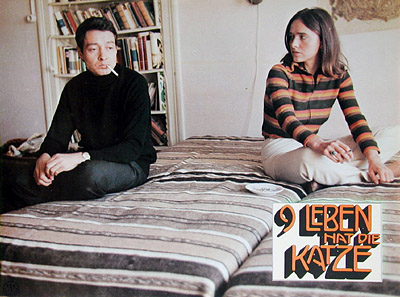
Festival Participation
17. Internationale Filmwoche Mannheim 196831. Edinburgh International Film Festival 1977
28. Internationale Filmfestspiele Berlin,
Retrospektive 1978
8. Film International Rotterdam 1979
9. Festival International de Films de Femmes, Creteil/Paris 1987
33. Westdeutsche Kurzfilmtage, Oberhausen 1987
1. Femme Totale im Revier, Dortmund 1987
1. Frauenfilm - Wochen, Koblenz 1988
4. Feminale, Köln 1988
Deutsches Filmmuseum Frankfurt am Main 1988
Goethe Institut: Rom 1980, Neapel 1980, Tunis 1990
Werkschau Arsenal/Babylon, Berlin 1995
Contents
There is one thing that each of the 5 women knows for certain: success is very attractive. So they are all looking for success. Each woman adapts herself to her own particular circumstance, according to character. Each believes to have found an individual way out of misery. The scale of misery determines the emotion. Katharina yearns for a life without sentimental obligations. She believes that she has achieved this. Therefore she views her beloved girlfriend Anne with even greater sympathy. Anne is at the moment learning the left-wing jargon. But it is pure helplessness. She thinks it is political commitment that makes her not trust her friend Katharina, so Anne smiles as well. Gabriele is involved with business. Her motto: it's fine if you like it. To herself she says: if Jesus had loved women, I would love him. Yes, they laugh.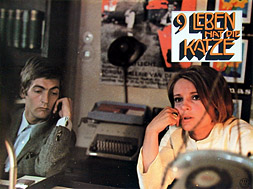
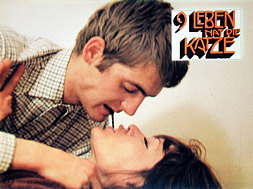
Magdalena holds on to her husband, Stefan, with an iron grip. He on the other hand loves any woman who gives him encouragement. Magdalena, the wife, has the smiling role. Kirke is a discovery. She can do everything: turn men into pigs. Or seduce them. Kirke, the ideal woman2, is not oppressed. She does whatever she wants. And she won't be laughed at.
These five women describe five possible modes of behavior for women, each of whom wants to break out of her state of dependence. It becomes clear that solidarity between women is difficult to achieve when striving for freedom. However it is only solidarity, which will help women achieve more freedom. And the men in this film? They see women only as beautiful beings, who solve their problems with gossip.
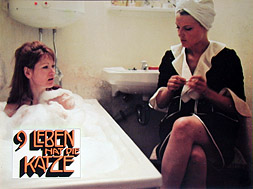
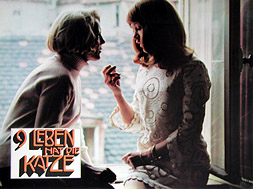
The Film
01: Ula Stöckl is a pioneer of women's film. At a time when in the old Republic there was neither a women's movement nor women's film she made the film The Cat Has Nine Lives (1968). This was her graduation film from the Institute for Film at the School of Design in Ulm (her teachers were Alexander Kluge and Edgar Reitz). The film disappeared without trace after the distributor, which had bought it and secured 600 cinema dates for it, went bust. It wasn't until many years later that it was re-discovered as West Germany's "first feminist film" (Christa Maerker) and it became a cult film of the 60s. In a relaxed, flirtatious and meandering manner it portrays the everyday experiences, desires, sexual acts and fantasies of different women: a German journalist, her French girlfriend and a German pop singer. Stöckl shocks both men and women with her use of cinematic metaphors for female lust. These elements of shock run through all her work. Other cinematic trademarks in this, her first film, also guide her later film work: such as the use of amateur and professional actors, or the bringing together of fantasy and dream sequences with raw elements of footage of real-life situations.Erika Richter 1995
to top
02: For me personally Ula Stöckl's film The Cat Has Nine Lives from 1968 is an important and beautiful film, which was made at a time when women were just beginning to tell their own stories using their own pictures.
Ute Aurand 1995
to top
Press
01: The films bring together different atmospheric profiles. It studies four women by looking at their body language, their reactions, their ways of speaking, their subconscious attempts to fit in. (...) A collection of thoughts, emotions, ripped open problems. A treasure-trove of argument topics for the way home from the cinema.Ponkie, Abendzeitung München
to top
02: "The Cat Has Nine Lives" was made as a graduation film at the institute of film design in Ulm. It reveals, through use of meticulously observed and lovingly enacted details, sympathy for both women, who actually know full well what they want, but sometimes haven't a clue, and again and again look for confirmation.
Annette Kilzer, Tip Berlin 6/95
to top
03: What sets Ula Stöckl apart is that she is talking about herself, her situation, the milieu she knows, her problems and her ideals. She doesn't make a film about just anything, but rather about her own affairs. She speaks about women in her own way, and therefore she reminds me of Agnes Varda much more than those who believe that they have learnt Varda's style. (...) Ula Stöckl's conclusion is that mainstream society cannot possibly satisfy women. One should take the word literally: Satisfy, not pacify (Marcuse's false and deadly interpretation of pacification). Only the highest level of satisfaction offers both freedom and independence.
Peter M. Ladiges, Film Kritik 12/68
to top
04: The most beautiful moments of Ula Stöckl's film are when she lets herself and her actors improvise, and when she uses techniques developed by the cinema verite. Her most impressive moments though are when she brings the film to an ending worthy of realist cinema.
Frieda Grafe, Süddeutsche Zeitung, 07.05.1971
to top
05: The Cat Has Nine Lives is a film in Cinemascope with the craziest montage I have ever seen, and yet most of the time it also flows as a whole. (...) The Cat Has Nine Lives is a wonderfully beautiful, deeply sad puzzle.
Maria Lang 1990
to top
06: It is the marvelous orgies of color in Ula Stöckl's debut film which impress even more. The Cat Has Nine Lives is, in its no-hold-barred subjectivity, an exciting experiment. It approaches characters, emotions, disturbed thoughts and disturbed emancipation in an extremely impressionistic way. It is a film about women by women, an almost beautifully bare statement.
Alf Brustellin
to top
07: What makes Ula Stöckl's film so endearing is that it doesn't pat itself on the back because of its own cleverness, but rather discusses the problem seriously and presents various characters in different pieces.
k.n., Schwäbische Zeitung 22.04.1971
to top
08: Ula Stöckl's first film The Cat Has Nine Lives was the real secret at this year's Mannheim film festival. That it didn't win the first prize has not bothered its director too much. "What has interested me most about the film was making it and working on it during filming. I kept filming each scene again and again. I could work my whole life on a film-set." This push for perfection is one of Ula Stöckl's main traits. She has coolly distant obsession with film, without ever getting too uptight.
C. v. B., AZ, 13.12.1968
to top
09: Her film centers on what is still socio-politically an explosive problem: the question of, to what extent a woman can be emancipated in a society which is ruled and organized by non-emancipated men.
Thomas Schröder, Die Welt, 14.10.68
to top


